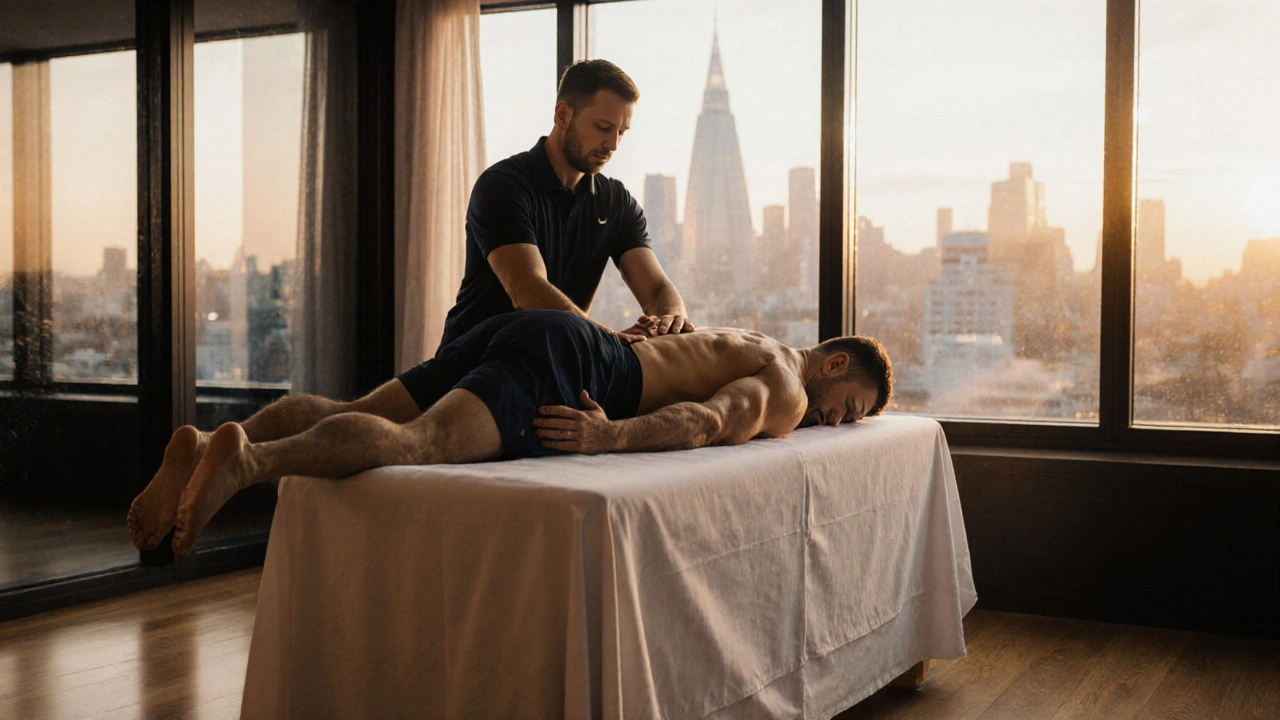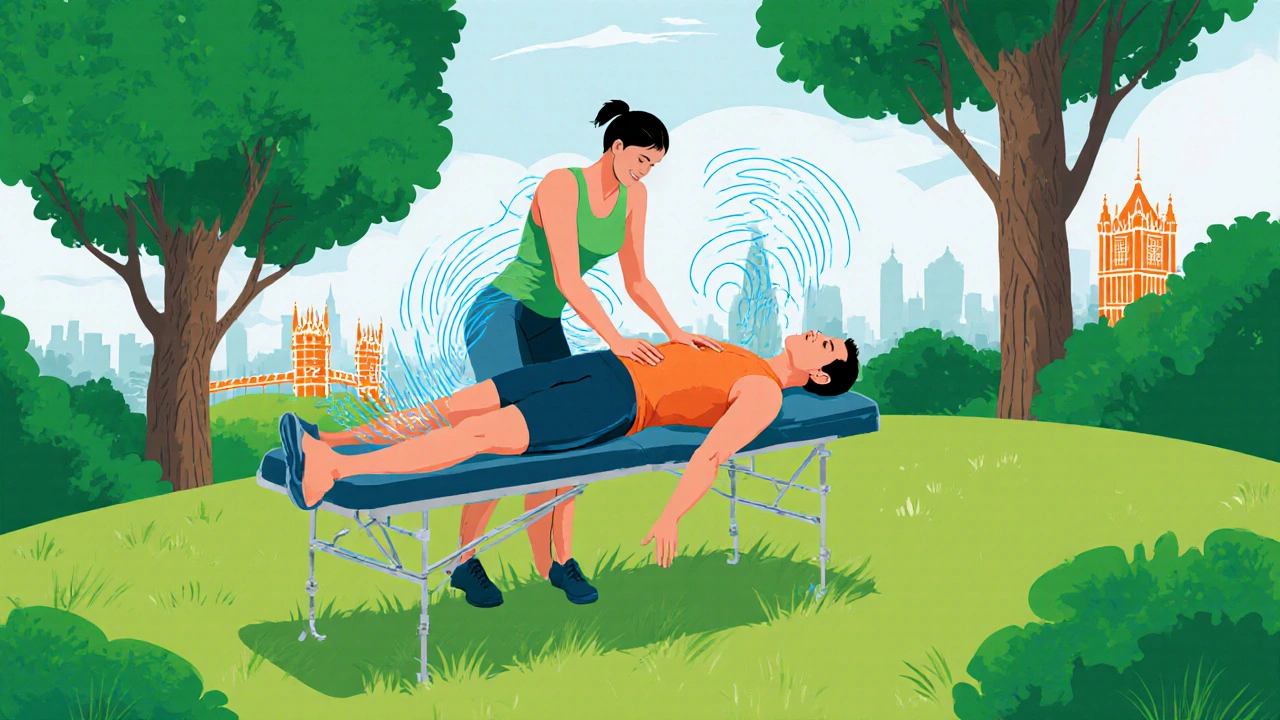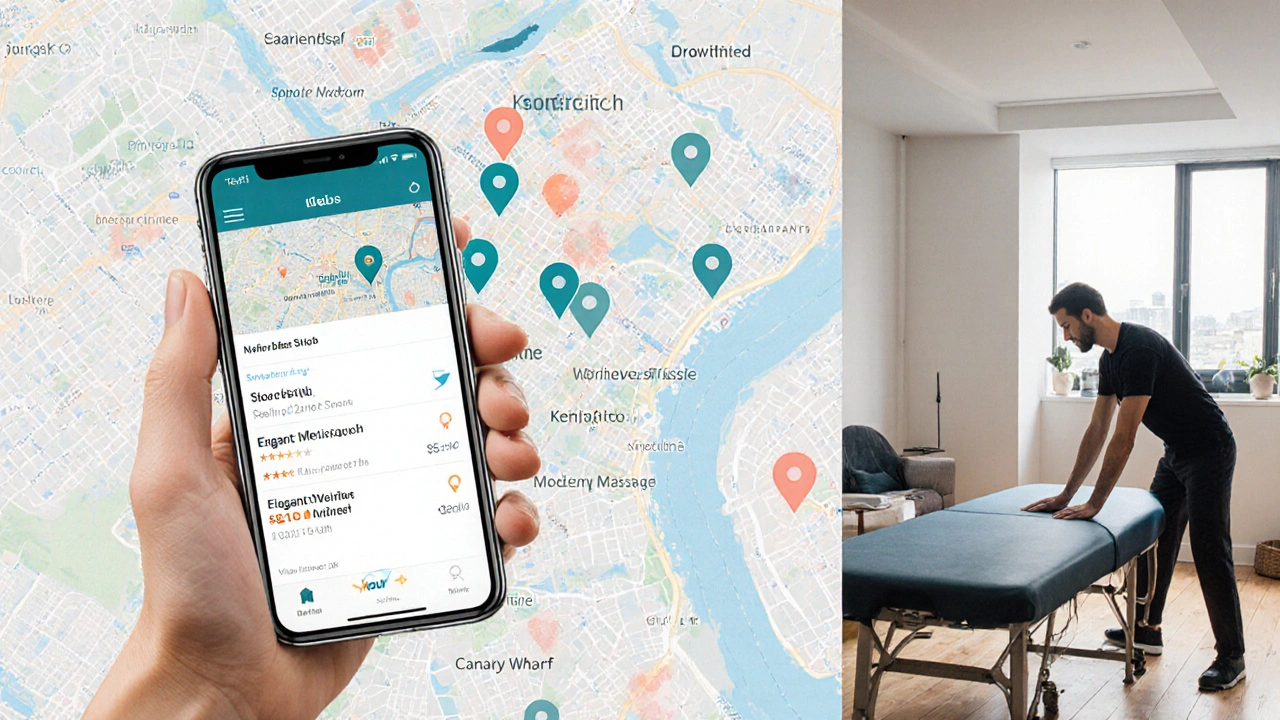Discover how sports massage in London boosts fitness, speeds recovery, and prevents injuries. Learn benefits, types, pricing, safety tips, and how to book your session.

- Created by: Archer Caldwell
- Completed on: 10 Oct 2025
- Categories: Sports Massage
When you hear Sports Massage a specialized hands‑on technique that targets athletes' muscles and joints to improve performance and speed up recovery paired with the bustling energy of London, you’ve got a powerful combo for anyone serious about fitness.
Key Takeaways
- Sports massage speeds up muscle recovery, reduces injury risk, and enhances performance.
- London offers a wide range of certified therapists, from boutique studios in Shoreditch to large wellness centres in Kensington.
- Typical sessions last 30‑90 minutes and cost £45‑£120, depending on therapist expertise and location.
- Look for qualifications like Level5 Sports Massage, membership in the Register of Massage Therapists (RMT), and experience with athletes.
- Safety tips: stay hydrated, communicate pain levels, and avoid massage on acute injuries without medical clearance.
Direct Answer
Sports massage in London is a targeted hands‑on therapy that helps athletes and active individuals improve flexibility, reduce soreness, and prevent injuries. Sessions typically combine deep‑tissue strokes, stretching, and trigger‑point work, and can be booked at specialist studios, gyms, or mobile therapists across the city.
Comprehensive Guide to Sports Massage in London
Imagine finishing a tough run in HydeHyde Park, feeling that post‑workout ache, and then slipping into a soothing session that not only eases the pain but also prepares your muscles for the next challenge. That’s what sports massage does - it bridges the gap between a hard workout and optimal recovery.
Definition and Context
Sports massage is a branch of therapeutic massage designed specifically for athletes and active people. Unlike a generic relaxation massage, it focuses on muscle groups used during sport, employing techniques such as:
- Effleurage - long, gliding strokes to warm up tissue.
- Friction - deep, cross‑grain pressure to break down adhesions.
- Trigger‑point therapy - pinpoint pressure on tight knots.
- Passive stretching - assisted stretches to improve range of motion.
In London’s high‑tempo lifestyle, sports massage has become a go‑to service for runners, cyclists, footballers, and even busy professionals who hit the gym after a long day.

Benefits of Sports Massage
Here’s why you’ll want to add it to your fitness routine:
- Faster Recovery: Increased blood flow flushes out metabolic waste, cutting downtime after intense sessions.
- Injury Prevention: Regular soft‑tissue work keeps muscles supple, lowering the chance of strains and tears.
- Improved Flexibility: Stretching under professional hands expands your range faster than solo stretching.
- Performance Boost: Athletes report better power output and endurance after a series of weekly massages.
- Mental Reset: The focused touch releases endorphins, reducing stress and sharpening focus for the next training block.
Take the example of a local football club in Camden; after incorporating weekly sports massages for their squad, the team saw a 15% drop in hamstring injuries over a season.
Types of Sports Massage Available in London
London’s diverse market means you can choose a style that matches your goals:
- Pre‑Event Massage: Light, energizing strokes to prime muscles before a race or match.
- Post‑Event Massage: Deeper work to flush out lactic acid and reduce soreness.
- Maintenance Massage: Regular 30‑45 minute sessions focused on chronic tight spots.
- Mobile / Outcall Massage: Therapists travel to your home, gym, or office - perfect for busy schedules.
- Specialist Sports Therapy: Combines sports massage with physiotherapy techniques for rehab purposes.
How to Find Sports Massage Services in London
Finding the right therapist is easier than you think. Follow these steps:
- Search reputable directories like the Register of Massage Therapists (RMT) or British Association of Sports & Exercise Medicine (BASEM) for members in London.
- Check reviews on Google and Trustpilot - look for comments about “athlete experience” and “post‑workout recovery”.
- Visit studio websites; many showcase therapist bios, qualifications, and client testimonials.
- Ask local gyms or sports clubs for recommendations - they often partner with trusted massage providers.
- Consider location: studios near transit hubs like King’s Cross, Liverpool Street, or South Bank reduce travel time before training.
For a quick visual, imagine a map of London dotted with spots in Shoreditch, Notting Hill, and CanaryWharf - each representing a vetted sports‑massage clinic.
What to Expect During a Session
First, the therapist will ask about your recent workouts, any injuries, and areas of tightness. This conversation ensures the treatment is tailored to you.
- Warm‑up Phase (5‑10 mins): Light strokes to increase circulation.
- Targeted Deep Work (15‑30 mins): Deep‑tissue pressure on specific muscle groups, often using forearms or elbows.
- Stretching & Mobilisation (5‑10 mins): Assisted stretches to improve joint range.
- Cool‑down (5 mins): Gentle effleurage to calm the nervous system.
Therapists usually ask for feedback on pressure - a simple “more” or “less” keeps the experience comfortable. Most sessions end with advice on hydration, post‑massage stretching, and any modifications for your next workout.

Pricing and Booking
London’s pricing reflects both location and therapist expertise:
| Service | Typical Session Length | Price Range (GBP) | Best For |
|---|---|---|---|
| Sports Massage (Entry‑Level) | 30‑45 mins | £45‑£70 | Recreational athletes, gym‑goers |
| Sports Massage (Advanced/Elite) | 60‑90 mins | £80‑£120 | Professional athletes, high‑intensity training |
| Deep Tissue Massage | 60 mins | £70‑£100 | Chronic tension, non‑sport specific relief |
Most clinics let you book online via their website or through apps like Treatwell. Book at least 24‑48 hours in advance if you need a specific therapist, especially for weekend slots.
Safety Tips
- Confirm the therapist’s credentials - look for Level5 Sports Massage certification and membership in a professional body.
- Never massage an acute injury (e.g., recent sprain) without a doctor’s OK.
- Stay hydrated before and after the session to help flush out toxins.
- Communicate pain levels; a good therapist will adjust pressure instantly.
- If you have conditions like hypertension, diabetes, or are pregnant, discuss modifications ahead of time.
FAQ: Your Questions About Sports Massage in London Answered
How often should I get a sports massage?
For most active people, a 30‑45 minute session once a week maintains flexibility and reduces soreness. Elite athletes might schedule two to three sessions per week around heavy training blocks.
Can sports massage replace physiotherapy?
Not usually. Sports massage complements physiotherapy by keeping tissue pliable, but it doesn’t provide the diagnostic and rehab protocols a physiotherapist offers for serious injuries.
What should I wear to a sports massage?
Comfortable, loose‑fitting sportswear works best. Most clinics provide sheets or blankets, so you can stay fully clothed or partially dressed as you prefer.
Is sports massage covered by NHS or private insurance?
Generally, the NHS does not cover it unless prescribed for a specific medical condition. Some private health plans may reimburse a portion if the therapist is a registered practitioner.
Can I get a sports massage at home?
Yes - many London therapists offer mobile services. Expect a higher rate (about £20‑£30 extra) for travel and equipment set‑up.
Ready to Elevate Your Fitness Journey?
If you’re serious about cutting recovery time, preventing injuries, and getting that extra edge in your workouts, a sports massage in London could be the missing piece. Explore the studios, book a trial session, and feel the difference for yourself.
Take the first step now - search for a certified London sports‑massage therapist and schedule a session that fits your routine.

David Smith
October 10, 2025 AT 15:12Great gude, I’ll try it out soon.
Woo Packaging
October 12, 2025 AT 22:46Thanks for the thorough rundown! It’s good to see the emphasis on Level 5 certification and RMT membership. For anyone new to the scene, I’d recommend cross‑checking therapist profiles on the RMT directory and reading at least three recent client reviews before booking. Also, staying hydrated before and after the session can really amplify the benefits. Keep up the great work!
Mike Ritchie
October 15, 2025 AT 06:19If you’re truly serious about performance, you shouldn’t settle for just any massage. Only studios that employ therapists with a background in elite sport science can deliver the nuanced biomechanics needed for optimal adaptation. In Shoreditch you’ll find pockets of such expertise, but beware of the generic wellness chains that market themselves as "sports‑focused" without any real credentials. A discerning athlete knows that quality trumps convenience every time.
Himanshu Parmekar
October 17, 2025 AT 13:52While the guide covers the basics, it glosses over the fact that many London clinics still lack proper post‑COVID sanitation protocols. A responsible therapist should be transparent about cleaning procedures, yet this is rarely mentioned. Also, the pricing range feels inflated for what is essentially a deep‑tissue session, especially when you can find competent practitioners in community sports centres for a fraction of the cost. Clearly, the market could benefit from more regulation.
Nasir Khan
October 19, 2025 AT 21:26For newcomers, it’s helpful to know that many community centres offer discounted sessions for students or low‑income members, making sports massage more accessible. When you reach out, mention any special circumstances you have – therapists are often willing to adjust pressure or techniques to suit your comfort level. Remember, the goal is to support your progress, not to intimidate you with jargon. Good luck on your recovery journey!
Jeff Brainard
October 22, 2025 AT 04:59Body is a vessel of motion its muscles sing the song of effort and rest in each massage the rhythm returns balance the hands trace pathways of strain and release the quiet after the work is the echo of resilience
Kumar Manickam
October 24, 2025 AT 12:32Starting a new recovery routine can feel daunting, but every small step adds up to big gains.
When you book your first sports massage in London, think of it as an investment in your future performances.
Even if you’re just jogging in Hyde Park, the extra circulation a good therapist provides will shave minutes off your next run.
Consistency is key, so aim for a weekly session if your schedule permits, and you’ll notice reduced soreness within a couple of weeks.
Don’t overlook the importance of post‑massage stretching; a brief routine can lock in the flexibility gains you just earned.
Hydration before and after the session helps flush metabolic waste, which speeds up the healing process.
Most therapists will ask for feedback on pressure, so feel free to say "more" or "less" – communication is part of the therapy.
If you have a lingering niggle, mention it early; targeted work can prevent a small issue from becoming a major injury.
Remember that a good sports massage complements, not replaces, your regular strength and conditioning program.
You might also explore mobile therapists who come to your home or gym, saving you travel time on busy days.
Pricing varies, but many studios offer package deals that bring the cost per session down, making it more affordable in the long run.
Some community clubs even subsidize sessions for members, so it’s worth asking your local gym about special rates.
The mental side matters too – the tactile pressure releases endorphins that can boost your mood and focus for the next workout.
If you’re training for an event, schedule the massage a day or two before the big day to keep muscles primed without feeling overly relaxed.
After the session, a light walk can help maintain circulation and extend the benefits throughout the day.
Overall, integrating regular sports massage into your routine is a smart strategy for longevity, performance, and enjoyment of your sport.
adam denature
October 26, 2025 AT 19:06Please note that the term "sports massage" should be hyphenated when used as an adjective, as in "sports‑massage therapist". Also, avoid using "you’re" in place of "your" when referring to the client’s schedule. Simple language helps clarity. Remember to proofread all booking forms for misspellings.
Honey Syal
October 29, 2025 AT 02:39Oh, because we all have endless spare cash just to splurge on a 90‑minute massage, right? It’s not like regular gym memberships or home stretching routines exist.